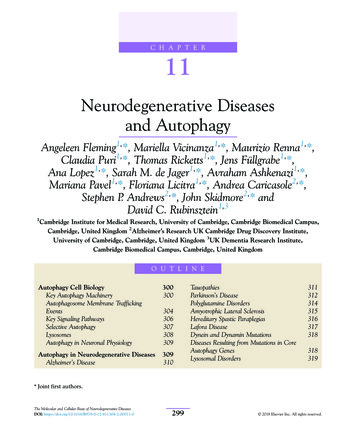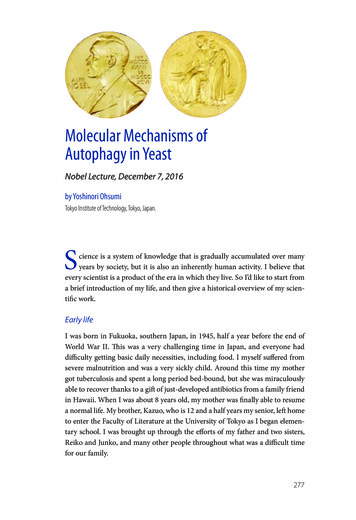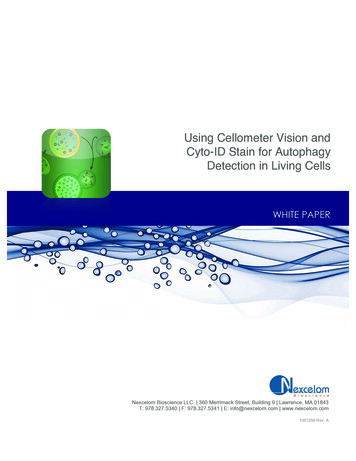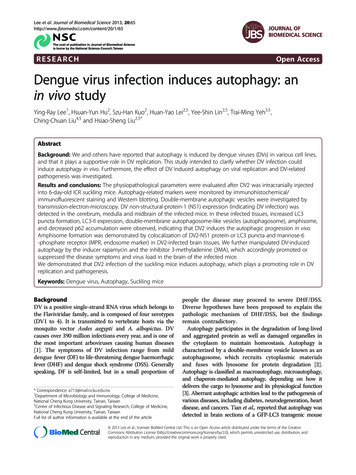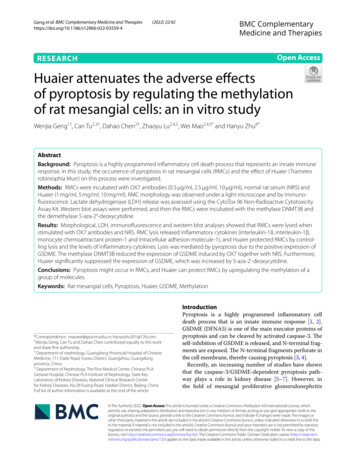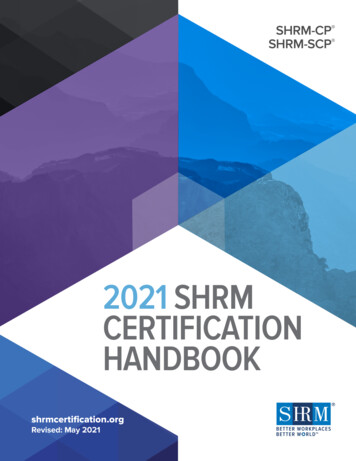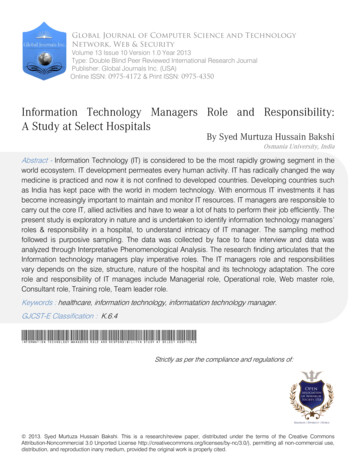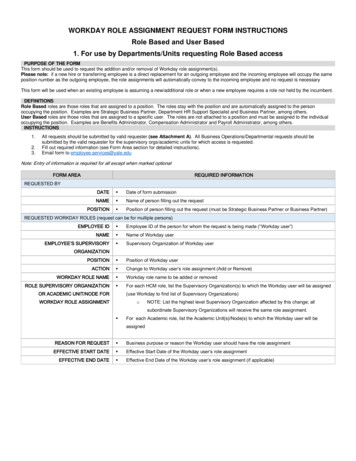
Transcription
Hassanpour et al. Stem Cell Research & 018) 9:305REVIEWOpen AccessDistinct role of autophagy on angiogenesis:highlights on the effect of autophagy inendothelial lineage and progenitor cellsMehdi Hassanpour1,2,3, Aysa Rezabakhsh4, Masoud Pezeshkian5, Reza Rahbarghazi2,6*†and Mohammad Nouri2,1*†AbstractAutophagy plays a critical role in the dynamic growth of each cell through different conditions. It seems that thisintracellular mechanism acts as a two-edged sword against the numerous cell insults. Previously, autophagy wasdescribed in the context of cell activity and behavior, but little knowledge exists related to the role of autophagy inendothelial cells, progenitors, and stem cells biology from different tissues. Angiogenic behavior of endothelial lineageand various stem cells are touted as an inevitable feature in the restoration of different damaged tissues and organs.This capacity was found to be dictated by autophagy signaling pathway. This review article highlights the fundamentalrole of cell autophagic response in endothelial cells function, stem cells dynamic, and differentiation rate. It seems thatelucidation of the mechanisms related to pro- and/or anti-angiogenic potential of autophagy inside endothelial cellsand stem cells could help us to modulate stem cell therapeutic feature post-transplantation.Keywords: Stem cell, Autophagy, Angiogenesis, Differentiation, Functional maturationTerms and definitionIn addition to synthesis, protein degradation is an important mechanism for the physiologic activity of eachcell inside the body. Cells commonly exploit two mainstrategies to degrade intracellular proteins, namely aubiquitin-proteasome system and autophagy [1].Autophagy is apparently a crucial and tight regulatednormal catabolic process for cell survival during growth,starvation, and differentiation and even plays fundamental biological roles in various cellular functions [1]. Inscientific literature, autophagy is defined as sequestrationof misfolded, impaired, and toxic aggregate-prone mutantproteins, whole damaged and dysfunctional organelles, orintracellular pathogens into double-membrane autophagicvesicles termed autophagosomes that finally merge withlysosome for degradation (autophagolysosome) [2].Regarding delivery pathway of the biomolecules to the lysosomes, three distinct types of autophagy mechanismswere previously discovered: (a) Macroautophagy that* Correspondence: Rezarahbardvm@gmail.com; rahbarghazir@tbzmed.ac.ir;Nourimd@yahoo.com†Reza Rahbarghazi and Mohammad Nouri contributed equally to this work.2Stem Cell Research Center, Tabriz University of Medical Sciences, Imam RezaSt., Golgasht St., Tabriz 5166614756, IranFull list of author information is available at the end of the articlesurrounds the material with a dual lipid membrane,named autophagosome and then fuses with lysosomes finally formed autophagolysosome; (b) microautophagy,which directly enters substances into the lysosomesthrough the intrusion of self-membrane (Fig. 1); and (c)CMA that is degradation of a proteins with specific motifs(KFERQ) targeted by HSC70 complex and then adhere tolysosome via LAMP2A (Fig. 1). Other aliases exist regarding autophagy such as aggrephagy, mitophagy, lipophagy,and xenophagy depending on which substance is sequestrated and digested [3, 4]. In this review, macroautophagywill be termed as autophagy. Autophagy is a general response to a diversity of external and internal stress stimuli.Under these conditions, autophagy is stimulated via signaling the mechanisms that ordinarily involve activationof the AMPK and inhibition of mTOR [5]. The process ofautophagolysosome formation involves initiation, elongation, and maturation stages and the following merge ofthe autophagosome with lysosomes to form an autophagolysosome [2]. Autophagy is initiated by a membrane nucleation that requires the ULK1 complex with FIP200,Atg13, Atg9, a regulatory class III PI3K complex that includes Beclin-1, known as Atg6, and Atg5-Atg12-Atg16multimerization complex [6] (Fig. 1). Under physiological The Author(s). 2018 Open Access This article is distributed under the terms of the Creative Commons Attribution 4.0International License (http://creativecommons.org/licenses/by/4.0/), which permits unrestricted use, distribution, andreproduction in any medium, provided you give appropriate credit to the original author(s) and the source, provide a link tothe Creative Commons license, and indicate if changes were made. The Creative Commons Public Domain Dedication o/1.0/) applies to the data made available in this article, unless otherwise stated.
Hassanpour et al. Stem Cell Research & Therapy(2018) 9:305Page 2 of 16Fig. 1 Autophagy is classified into three types based on the route of delivery. Microautophagy refers to the sequestration of misfunction proteinsor whole organelles such as mitochondria (named mitophagy) directly by lysosomes. Chaperone-mediated autophagy (CMA) involves directtranslocation of misfolded substrates across the lysosome membrane through the action of a cytosolic and lysosomal chaperone hsc70, and theintegral membrane receptor LAMP-2A (lysosome-associated membrane protein type 2A). In the case of macroautophagy, the cargoes aresequestered within a unique double-membrane cytosolic vesicle, named autophagosome. This type of autophagy is initiated by the nucleation ofan isolation membrane or phagophore. ULK, ATG 13, FIP200, and ATG101 are involved in this stage. Then, the Beclin-1 and ATG14L complexcontributes to the nucleation of the phagophore. This membrane then elongates and closes on itself to form an autophagosome. Elongation ofthe phagophore membrane is dependent on the Atg12 and LC3 conjugation systems. Closure of the autophagosome is dependent on theactivity of the LC3-conjugation system. The autophagosome matures by fusing with endosomes and lysosomes, finally forming theautophagolysosome where the cargo degradation occursconditions, mTOR prevents autophagy by the phosphorylation and inhibition of Atg13 activity that inhibits itsinteraction with ULK1. mTOR also prevents ULK1 activity by phosphorylation of ULK1 and disrupting the interaction between ULK1 and AMPK [7]. In the absence ofthese inhibitory signals, Atg13 and ULK1 interact withAtg17 and the ULK1-Atg13-Atg17 complex to initiateautophagosome formation. Recruitment of Atg9 to theULK1-Atg13 complex is a key step for the primary lipidation of pre-autophagosomal structure membrane [8]. Thenext steps are regulated by a complex of Beclin-1 withPI3K-III and Atg14 [9]. As soon as autophagy isstimulated by starvation and hypoxia, Atg14 (thepre-autophagosome protein) accumulates at the endoplasmic reticulum-mitochondrion contact surface in aSNARE, syntaxin 17-dependent manner [10]. Atg14 connects PI3K molecules to Beclin-1 and results in the development of a complex on the pre-autophagosomalstructure [10]. Afterward, many of the Atg proteins willfocus on the pre-autophagosomal structure; therefore, the
Hassanpour et al. Stem Cell Research & Therapy(2018) 9:305pre-autophagosomal structure is considered to be linkedto the formation of the autophagosomes [11]. Moreover,Beclin-1 is released from Bcl-2 and forms a complex withthe ultraviolet radiation resistant gene/activating moleculein Beclin 1-regulated autophagy [12]. This complex startsconjugation of Atg12 to the substrate Atg5 by Atg7 andAtg10 to form an Atg5-Atg12-Atg16 multimeric complex[13]. Atg4 converts LC3 from LC3β-I, free-form, toLC3β-II, in phosphatidylethanolamine-conjugated form,that regarded as a crucial step in autophagosome formation. The LC3β-II is conjugated via phosphatidylethanolamine irregularly on both sides of the membrane by Atg9within the ULK complex [14]. This process will more continue until the end of the autophagosome formation. So,LC3β-II is released from the external surface of the membrane. Then, from this conception, it can be concludedthat LC3β-II can serve as an analytical marker for monitoring autophagic flux [15]. The newly formed autophagosome together with the cargo to be degraded finally mergewith lysosomes to form an autolysosome that their content is lysed by lysosomal enzymes [2]. By transferring theautophagosomes to lysosomal proximity, microtubulesregulate and facilitate the fusion of autophagosomes withlysosomes. Then, LAMP1/2, lysosomal membrane proteins, Rab7 (member of Rab GTPases family), SNARE,class III Vps, and endosomal sorting complexes are required for transport which mediates the process of fusion[16, 17]. Finally, the formation of the autolysosome provides an acidic environment that is essential for the idealactivity of lysosomal hydrolases, cathepsins and cargo degradation [18]. Amid autophagy factors, p62 is degradedalong with the targeted proteins and organelles, while LC3may be degraded or recycled back into the cytosol pool[19]. It is noteworthy to conclude that the pattern of autophagy proteins reveals the state and progression of autophagy. Activation of autophagy contributes to theaccumulation of LC3-bound, increased LC3-II/I ratio, andreduction of p62 levels, reflecting degradation in the autolysosomes [20]. The defect of autophagy at the beginningstage is characterized by a decreased LC-3-bound, loss ofLC3-II, and raised p62 levels inside cells [21–23]. Failureof the final phases of autophagy, autophagosome-lysosomefusion or cargo degradation, is characterized by a normalor increased number of LC-3-bound, increased LC3-II andp62 in the cell that revealed a failure to clear autophagosomes and degrade p62 (Fig. 1) [22].Effect of autophagy on various SC differentiationDespite distinct features of self-renewal, differentiation, multi-potency, and quiescence status in different organs, SCs should improve the restorativepotency of organelles turnover [24]. In this regard,autophagy as a well-known quality control process isessential for the high maintenance of SCs homeostasisPage 3 of 16[25]. Based on their origin, SCs could be classifiedinto two types and one of them is ESCs that is originated from inner cell mass of murine and humanblastocytes and the second one is ASCs seen isolatedfrom adult tissues. Compare to ESCs, ASCs, but notall types such as intestine crypt stem cells, pose alimited stemness feature which is localized in specificmature sites to repair tissues in response to certaindiseases [26, 27]. Maintenance of balance betweenstemness and differentiation in SCs is a very important issue [28]. An excessive differentiation rate maylead to cell aging, while untamed cell proliferationcan raise the emergence of cancer cells formation[29]. Growing body of evidence revealed that autophagy modulates differentiation in both ESCs and ASCs[30]. It seems that autophagy is one of the indirect metabolic pathways that can be modulated in both ESCs andASCs. Thus, we briefly scoped the crucial role of autophagy response in the maintenance of stemness and differentiation of various SC types. Commensurate with thesedescriptions, autophagy response and related signalingpathways have potential to direct and inspire distinctphenotype and cell function in SCs in the favor of regeneration or reduce restorative capacity.Role of autophagy on ESCsAutophagy has an essential role during cell reprogramming and embryogenesis period [31]. Autophagyresponse is commonly upregulated at an early stageof human and murine SC differentiation [32]. In linewith this statement, some pharmacologic agents areused for deciphering autophagy effects on the differentiation capacity of SCs [33, 34]. HMBOX1, knownas a transcription repressor, has the ability to regulateautophagy [35]. Inhibition of HMBOX1 could per seinhibit the autophagy while the promotion of this factor stimulates autophagy flux [35]. It has been reported that during MSC and ESC differentiation intoendothelial-like cells, the stimulation of HMBOX1 coincided with the induction of autophagic response[35]. It has been elucidated that HMBOX1 potentiallyinteracts with MT2A to initiate autophagy while inhibitingapoptosis in vascular ECs [35]. Under treatment with autophagy inducer such as rapamycin ESCs transition intoosteoblast cells was promoted by the inhibition of mTORand promotion of BMP/Smad signaling pathway [36]. Autophagy also increased human ESCs’ survival by SIRT-1activation and subsequent mTOR inhibition against oxidative stress-induced damages [37]. The factor SIRT1 wasfound to stimulate autophagy-related signaling pathwayand improve mitochondria function in ECs under oxidative stress. There is a close relation with autophagy andcytokines participating in stemness acquisition [38, 39].For instance, it was reported that LIF is required to
Hassanpour et al. Stem Cell Research & Therapy(2018) 9:305preserve the multi-potency of murine ESCs [38, 39]. Invitro depletion of LIF from medium has the potential totrigger mTOR signaling pathway through the modulationof ERK/Tuberin axis [40]. LIF depletion also contributesto the activation of MEK/ERK/TSC2 transition from theLIF/STAT3-induced pluripotent state to the fibroblastgrowth factor receptor 2/ERK-committed differentiationgoverned by mTOR signaling activation [39]. In anexperiment, it was shown that Atg3 / , Atg3 / , andFOXO-1 / murine ESCs lost the potency of self-renewaland differentiation capacity [41]. The high autophagic fluxrate ensures ESC entity through engaging autophagy machinery effector termed FOXO-1. This factor acts a pivotalrole in the regulation of SOX2 and OCT4 (POU5F1) expression [41, 42]. There is an inevitable correlation between FOXO-1 level and the expression ofautophagy-related genes. The deficiency of autophagygenes such as Atg5 and Beclin-1 has long been reportedESCs during embryogenesis and fetal development [43].Both genes participate in SC cavitation during the formation of the embryoid body [43]. Even, modulating autophagy under insulting condition could have some beneficialoutcomes regarding SC orientation toward specificphenotypes.During starvation, the induction of autophagy viathe treatment of rapamycin could induce morphological changes by degrading the midbody ring priorto cell-to-cell separation [44]. By using Atg5-null oocytes and sperms, the generation of the blastocystand therefore inner cell mass was stopped [45]. Commensurate with these comments, the ablation ofBeclin-1 gene leads to early embryonic lethality inmurine ESCs [46]. Some compensatory mechanismcould be activated in autophagy-deficient conditions.For example, the ubiquitin-proteasome system degrades the damaged organelles and unfolds proteinsin response to autophagy insufficiency [47]. This reciprocal crosstalk between the ubiquitin-proteasomesystem and autophagy signaling has been documentedin human autophagy-deficient ESCs. To further followautophagic state on cell differentiation capacity duringearly embryogenesis, HESC-GFP-LC3 cell line wasestablished based on the expression of the greenfluorescent protein encoded with some pluripotencymarkers [48]. Ambra1 deficiency, as a positive regulator of autophagy, may cause embryonic lethality andlack of Ambra1 function, increased apoptotic changesand predisposed nervous system insufficiency [49].Overall, autophagy is an essential element for an earlyembryogenesis and differentiation during the development of the embryo. By controlling the effectorsthrough autophagy signaling pathway, we are able tomodulate the differentiation and orientation of distinctSCs toward specific lineages.Page 4 of 16Role of autophagy on HSCsThere are a plethora of experiments implicating the roleof autophagy on the dynamic hemostasis of HSCs. HSCscan differentiate to blood progenitor cells and restore allblood cell types. In the absence of autophagy, differentiation of HSCs into mature lineages was disrupted andthe possibility of malignancies would increase [50]. Forinstance, in null Atg5 / mice, an increased cellapoptosis in cytotoxic CD8 T cells was observed withthe occurrence of lymphopenia [51]. Other authors demonstrated that mutation of another autophagy memberAtg7 in hematopoietic system yielded an impaired mitophagy by enhancing of ROS generation, oxidative stressand DNA damage in erythrocytes with subsequentanemia and defective self-renewal [50]. The applicationof siRNAs targeting Atg 5 and Atg 7 fails to generatecolony formation in HSCs in vitro [32]. These resultsshow that autophagy mainly preserves self-renewal andmultipotency of HSCs in human or murine models [32].The factor LKB1, a Serine/threonine-protein kinasetumor suppressor, has an indispensable role in maintaining energy hemostasis [52]. Lack of LKB1 in mouse HSCleads to cell cytotoxicity and accumulation of LC3-II inthe bone marrow, spleen, and thymus [53]. Recent studies confirmed that the modulation of miRNAs, miR-17, 20, 93, and 106 have the potency to regulate thedynamic growth of HSCs through the downregulation ofgene p62 [54]. P62, an adaptor protein, plays a key rolein proteasomal and autophagy degradation pathway [55].Based on the data from recent studies, autophagy rolewas shown in the last stages of HSC differentiation [54].Some factors could control the activity ofautophagy-related genes [56]. For instance, GATA1 as acrucial regulator of the hematopoietic system could alsocontrol MAP1LC3B as well as lysosomal biogenesis factors [56]. Recent findings declared that transcription ofautophagy-related genes was enhanced during fetal HSCdifferentiation in murine embryo indicated by single-cellRNA sequencing technique [57]. In Tie2 HSCs, mitophagy was found to have an essential role in impairedmitochondria clearance and the maintenance of stemness feature of murine HSCs [58]. By inducing PINK1and PRKN genes, two key regulators of mitophagy, thedifferentiation property of HSCs was confirmed in highlevels [58]. Deletion of PINK1 and PRKN genes caused afailure in the regeneration and renewal activity of HSCs.Regarding these comments, it is noteworthy that autophagy is an essential element for stable quiescence in HSCs[59]. This finding strongly supports a notion that autophagy not only has a pivotal role in multipotency and remodeling of HSCs under physiologic condition but alsopreserves stemness of HSCs by decreasing oxidative stress[60]. Interestingly, autophagy activity is touted as an important mechanism to suppress HSCs metabolism and
Hassanpour et al. Stem Cell Research & Therapy(2018) 9:305preserve stemness with aging [61]. The regulation of basalcell metabolism and function of young and old SCs isdone via engaging autophagy-related effectors [61]. A factor titled FOXO3 activates a Bcl-2 interacting mediator ofcell death and promotes mitochondrial depolarization andsubsequent ROS generation. The activation of FOXO3could prohibit ROS production by survivin activation andBCL-XL inhibition. Notably, FOXO3A regulates apro-autophagy gene expression status to maintain HSCsby autophagic responses following the occurrence ofmetabolic stress [62]. Mutant Beclin-1 / or Atg5 / HSCstrigger the upregulation of Bcl-2 expression, causing genomic instability, aneuploidy, and DNA and chromosomaldamages [63]. A protective effect of autophagy on HSCgenomic integrity and reconstitution capacity was indicated in irradiated mice [64].Role of autophagy on NSCsEvidence point NSCs could proliferate and differentiateinto other types of neural lineages. For the first time, theeffect of autophagy was investigated on in vitro model ofmurine neuroblastoma cell line N2a cells [65]. Similar toother stem cell types, the critical role of FOXO1,FOXO3, and FOXO4 have been documented on the dynamics of murine NSCs. For instance, in FOXO1,FOXO3, and FOXO4 null mice, oxidative stress and uncontrolled ROS production abrogated NSCs’ proliferation and inhibited the NSC differentiation potential [66].Atg9a high expression rate (synaptic proteins) inducedby miR-34a downregulation was shown to affect themurine NSC differentiation feature [67]. Another studyconfirmed that deletion of ULK-interacting proteinFIP200 required for autophagosomes increased ROScontent and superoxide level during p62 aggregation.These features promoted NSCs cell death throughp53-dependent apoptosis pathway and cell cycle arrest[68]. Under in vivo condition, FIP200 is also required forNSC differentiation in the sub-ventricular zone of neonatal mice by the simultaneous limitation of microgliaactivity [69]. Suppression of SIRT1, a member of the sirtuin family, also could impress the NSC differentiationas well [70]. The expression of MiR-34a reduced SIRT1expression and enhanced NSCs maturation rate and differentiation potential [71]. These findings support thenotion that autophagy has a crucial role in NSC differentiation. A large number of experiments proposed therole of autophagy on embryonic and adult neural stemcells. According to recent findings, the expression ofMapLC3a, Belcin-1, Atg7, and Ambra1 were significantlyincreased in in vitro model of murine olfactorybulb-derived NSCs [72]. In Ambra1 knockout mice,neural differentiation was abrogated and followed byneural tube defects during embryogenesis [49]. By suppressing Atg5 in the murine cerebrocortical region, thePage 5 of 16defective neurogenesis was observed [73]. Chemical induction of SC differentiation promoted the increasedGFP-LC3 punctae and genetic/chemical inhibition of autophagy caused defective differentiation in N2a cells [65].In the autophagy-related pathway, the role of lysosome indegradation is not indispensable. Then, lysosomal dysfunction leads to neural or non-neural death because ofextra-accumulation of autophagosomes [74]. It has beenposted in an experiment that the deletion of gene Atg7could also amplify the neural cell death caused bychemical inhibition of autophagy at a late stage [75].Ataxia telangiectasia mutated protein kinase has a keyrole in response to DNA damages and impaired genomic integrity. In Ataxia telangiectasia-mutated proteinkinase-deficient NSCs, oxidative stress and ROS accumulation appeared by p38-MAPK activation and p16induction [76, 77]. Considering dual roles of autophagyon cell dynamic, recent findings proposed that the infection of human fetal NSCs by Zika virus via NS4a Aand NS4B (two important Zika proteins) inhibitsAkt-mTOR signaling and induces abrupt autophagy,leading to defective neurogenesis and cell death [78].Consistent with such an idea, autophagy also serves as aquality control mechanism in the hippocampal region bypreserving stemness and neurogenesis rate. Also, autophagy has the potential to eliminate defective NSCs followinginsulin withdrawal by type 3 ryanodine receptor-mediatedendoplasmic reticulum Ca2 regulation of autophagy andprogrammed cell death in NSCs [79, 80].Role of autophagy on MSCsMSCs are pluripotent SCs that can differentiate into avariety of cell types including osteoblasts, chondrocytes,fibroblasts, adipocytes, and ECs. During differentiationto various cell lines, some factors are required for theosteogenic-adipogenic switch. For example, culturingdensity, cell shape, stimulatory growth factors, structuralproperties, and the levels of Rho GTPase (Rho-A) activity seems to be important [81, 82]. Although there is alittle knowledge about autophagy role on MSCs, somestudies demonstrated that autophagy has an essentialrole in oriented differentiation of MSCs and touted as atherapeutic value especially in regenerative medicine.The more recent experiment confirmed that autophagy induction sustains MSCs survival rate and promotes MSCsproliferation and differentiation into neural-like cells by increasing neuron-specific enolase and microtubule-associatedprotein 2 expression [83]. In pre-adipocytes, Atg7 and Atg5mutations caused the reduction of adipose mass and differentiation, and an enhanced insulin sensitivity of Beclin-1promoted differentiated chondrocytes cell death [84]. Autophagy also could protect mesenchyme-derived chondrocytes during the occurrence of osteoarthritis throughengaging ULK1, BECN1, and MAP1LC3A [85]. Likewise,
Hassanpour et al. Stem Cell Research & Therapy(2018) 9:305constitutive autophagy response plays an essential role in osteocytes hemostasis. Silencing the RB1CC1/FIP200 complexgenes, essential for autophagosome formation, caused disruption of osteogenesis in osteoblasts in vitro and in vivomodels [86]. Moreover, autophagy participates in osteogenicdifferentiation of human dental pulp derived-MScstime-dependently through mTOR inhibition-mediated autophagy and late activation of Akt/mTOR signaling pathways [87]. It is important to note that competent autophagyactivity is limited to undifferentiated MSCs. Recent datashowed that the level of GFP-LC3 puncta in primarymurine bone marrow stromal cells isolated fromGFP-LC3 transgenic mice is significantly low after differentiation into osteoblast cells [86]. Moreover, the authors demonstrated that autophagy induction protectedprimary and cell line MSCs from apoptotic cell deathunder the hypoxic condition and serum deprivation byreleasing anti-apoptotic or pro-survival factors [88, 89].Contradictory findings revealed the modulatory effectof autophagy in MSC-based cell therapy. In betterwords, the suppression of autophagy could acceleratethe liver regeneration in the in vivo model of acute liverfailure [90]. Interestingly, the quality control of autophagy plays an indispensable role in neurodegenerativediseases such as Alzheimer and Parkinson. Vice versa, arecent finding demonstrated the interactive role ofMSCs against autophagy machinery system. In fact,MSCs enhance autophagic activity and subsequentlyβ-amyloid clearance in Alzheimer’s disease [91]. SIRT1protein as one of the key modulator of autophagy machinery influences the MSC differentiation. SIRT1 can promotethe mesangial cell proliferation under high glucose condition and restrict expression of aged MSCs phenotypes.Mutation of miR-195 in aged MSCs enhanced SIRT1 function and anti-age relating factors including FOXO1, Akt,and telomerase reverse transcriptase [38, 92, 93].Role of autophagy on MPCs and CPCsThe skeletal muscles are polynucleated syncytial cellswhich composed of myofibers and carry out the growthand the repair of muscle cells. The existence of MPCsknown as satellite cells plays a crucial on muscle restoration [94]. During muscle development, embryonic myoblasts differentiate to adult myofibers and constitute themature muscles. These myofibers are responsible for thefurther development of neonatal myogenesis [94]. Satellite cells are entirely quiescence while after muscle damage fused to damaged muscles and stimulate the muscleproliferation and differentiation. The effect of autophagyon MPCs just has been investigated recently. García-Pratand co-workers showed that the population of murinesatellite cells, in Atg-7 ( / ) mutant cells notably reduced[95]. In agreement with this finding, in aged satellitecells, a similar phenotype of Atg7-deficient cells wasPage 6 of 16observed coincided with enhanced senescence markerssuch as p16INK4a, P15INK4b, p21CIP1, and increasedoxidative stress. Additionally, DNA damage and p62 aggregation were imitated. Moreover, reduction of autophagic flux was detected in satellite cells isolated fromaged mice [96, 97]. Autophagy regulates satellite cells’bioenergetics feature during cell function and circadianrecycling of cell damaged ingredients and organelles [98,99]. CPCs have the ability to differentiate into ECs andsmooth muscle cells besides cardiomyocytes. Suppression of FGF signaling axis is required for CPC differentiation capacity [100]. By activating FGF receptors,autophagy machinery was inhibited by the engagingAkt-MAPK pathway. On the other hand, the inductionof autophagy, in turn, blocks FGF receptors and promotes the CPC differentiation. Due to the role of autophagy on maintenance of CPCs survival, autophagyinduction is one of the most important strategies besidesthe SCs derived exosomes and expression of miRNAs inSC therapy of ischemic myocardium [101].Role of autophagy on CSCsRecently, most of the studies focused on autophagy role incancer stem cell characteristics [102, 103]. In a comparisonof other stem/progenitor cells, CSCs have a similarself-renewal property but a higher level of basal autophagyactivity especially under hypoxic niche beside of metastasispotency and resistance against chemotherapy [104, 105].Considering the dual role of autophagy in eithertumor-suppressing or tumor-promotion, autophagy effecton CSCs strongly correlates with cancer type and the stageof tumor development [106]. In the case of tumor suppression, the contradictory data implicated that mutation of thePTEN gene emerged during malignant differentiation ofSCs while PTEN downregulation is associated with repopulation and tumorgenesis capacity of CSCs [107–109]. Thehigh content of PTEN promotes autophagy induction andlimits the CSC activity. In contrast, autophagy inhibition bythe silencing of BECN1 and ATG7 genes was found to abrogate the self-renewal of breast cancer cells both in vivoand in vitro models [110, 111]. In an experiment, it was unveiled that FIP200, as a very important regulator of autophagy, reduced the tumor-propagating of both aldehydedehydrogenase 1 positive and CD29hiCD61 breast CSCsthrough suppressing the EGFR/Stat3 and TGF-β/Smad axis[83]. Moreover, loss of autophagy reduced survival rates ofchronic myeloid leukemia CD34 progenitor cells whilepromoting the acute myeloid leukemia progenitor cellsproliferation [103]. Yang and co-workers also showed asimilar trend. It was shown a pro-survival activity in colorectal CSCs relied on oxaliplatin-induced autophagy thatparticipates in the maintenance of stemness andchemo-resistance [112]. A study also implicated thatpharmacological blocking of factor Notch leads to
Hassanpour et al. Stem Cell Research & Therapy(2018) 9:305autophagy activity and subsequen
SNARE, syntaxin 17-dependent manner [10]. Atg14 con-nects PI3K molecules to Beclin-1 and results in the devel-opment of a complex on the pre-autophagosomal structure [10]. Afterward, many of the Atg proteins will focus on the pre-autophagosomal structure; therefore, the Fig. 1 Autophagy is classified into three types based on the route of delivery.
